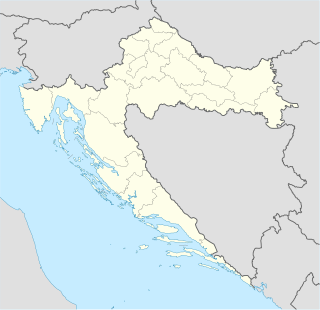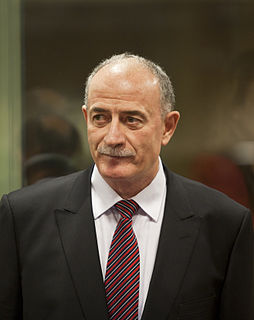
Vjekoslav "Maks" Luburić was a Croatian Ustaše official who headed the system of concentration camps in the Independent State of Croatia (NDH) during much of World War II. Luburić also personally oversaw and spearheaded the contemporaneous genocides of Serbs, Jews and Roma in the NDH.

August Cesarec was a Croatian writer and left-wing politician.

The Croatian War of Independence was fought from 1991 to 1995 between Croat forces loyal to the government of Croatia—which had declared independence from the Socialist Federal Republic of Yugoslavia (SFRY)—and the Serb-controlled Yugoslav People's Army (JNA) and local Serb forces, with the JNA ending its combat operations in Croatia by 1992. In Croatia, the war is primarily referred to as the "Homeland War" and also as the "Greater-Serbian Aggression". In Serbian sources, "War in Croatia" and (rarely) "War in Krajina" are used.

The Vukovar massacre, also known as the Vukovar hospital massacre or the Ovčara massacre, was the killing of Croatian prisoners of war and civilians by Serb paramilitaries, to whom they had been turned over by the Yugoslav People's Army (JNA), at the Ovčara farm southeast of Vukovar on 20 November 1991, during the Croatian War of Independence. The massacre occurred shortly after Vukovar's capture by the JNA, Territorial Defence (TO), and paramilitaries from neighbouring Serbia. It was the largest massacre of the Croatian War of Independence.
The Lora prison camp was a prison camp in Split, Croatia. It was active from 1992 to 1997 with mainly Serbian residents of Split and prisoners of war being imprisoned throughout the Croatian War of Independence. The camp was the site of human rights abuses resulting in a controversial trial, acquittal, retrial and conviction of prison guards. At least 70 inmates were killed over the course of its existence.

The Čelebići camp was a prison camp run by joint Bosniak and Bosnian Croat forces during the Bosnian War where Serb prisoners were detained and subjected to murder, beatings, torture, sexual assaults and otherwise cruel and inhumane treatment. The facility was used by several units of the Bosnian Ministry of the Interior (MUP), Croatian Defence Council (HVO) and later the Bosnian Territorial Defence Forces (TO). It was located in Čelebići, a village in the central Bosnian municipality of Konjic.

Veselin Šljivančanin is a former Montenegrin Serb officer in the Yugoslav People's Army (JNA) who participated in the Battle of Vukovar and was subsequently convicted on a war crimes indictment by the International Criminal Tribunal for the Former Yugoslavia for his role in the Vukovar massacre. His prison sentence was changed twice, from five to seventeen to ten years. He has since been ordered released by the ICTY on time served and good behavior.

The Siege of Dubrovnik was a military engagement fought between the Yugoslav People's Army (JNA) and Croatian forces defending the city of Dubrovnik and its surroundings during the Croatian War of Independence. The JNA started its advance on 1 October 1991, and by late October, it had captured virtually all the land between the Pelješac and Prevlaka peninsulas on the coast of the Adriatic Sea, with the exception of Dubrovnik itself. The siege was accompanied by a Yugoslav Navy blockade. The JNA's bombardment of Dubrovnik, including that of the Old Town—a UNESCO World Heritage Site—culminated on 6 December 1991. The bombardment provoked international condemnation, and became a public relations disaster for Serbia and Montenegro, contributing to their diplomatic and economic isolation, as well as the international recognition of Croatia's independence. In May 1992, the JNA retreated to Bosnia and Herzegovina, less than 1 kilometre from the coast in some places, and handed over its equipment to the newly formed Army of Republika Srpska (VRS). During this time, the Croatian Army (HV) attacked from the west and pushed back the JNA/VRS from the areas east of Dubrovnik, both in Croatia and in Bosnia and Herzegovina, and by the end of May linked up with the HV unit defending the city. Fighting between the HV and Yugoslav troops east of Dubrovnik gradually died down.
Sremska Mitrovica prison is the biggest prison in Serbia, consisting of two facilities. It is situated in Sremska Mitrovica, Vojvodina province.

The Holocaust in the Independent State of Croatia is a term which is primarily used in reference to the genocide of Jews, but sometimes, it is also used in reference to the genocide of Serbs and Romani (Porajmos), within the Independent State of Croatia, a fascist puppet state which existed during World War II, was led by the Ustaše regime, and ruled an occupied area of Yugoslavia which included most of the territory of modern-day Croatia, the whole of modern-day Bosnia and Herzegovina and the eastern part of Syrmia (Serbia). Of the 39,000 Jews who lived in the NDH in 1941, the United States Holocaust Memorial Museum states that more than 30,000 were killed. Of these, 6,200 were shipped to Nazi Germany and the rest of them were killed in the ISC, the vast majority were killed in Ustaše-run concentration camps, such as Jasenovac.

Milan Kalabić was a Serbian military officer who fought in the Balkan Wars and the First World War and was involved with the Chetniks during the Second World War. He collaborated, from 1941 until 1942, with the collaborationist government of Milan Nedić as an officer in the Serbian State Guard and the county prefect of Kragujevac. He also aided the Chetniks, which would result in his execution by the Gestapo in October 1942. He was the father of Chetnik commander Nikola Kalabić.

The Bučje camp was an internment camp run by rebel Croatian Serb forces during the early stages of the Croatian War of Independence. Located in the village of Bučje near Pakrac, the camp was used for the imprisonment of 200–300 Croatian civilians, prisoners of war, other non-Serbs, as well as Serbs that sided with the Croatian government or refused to join Serbian paramilitary groups. The camp was the site of numerous war crimes including murder, rape and torture. Twenty-two detainees are still listed as missing as of December 2013.
The Batković camp was a prison camp operated between 1992 and 1996 by Bosnian Serb authorities in Batković, a village in the municipality of Bijeljina, Bosnia and Herzegovina during the Bosnian War. It is believed to have been the first concentration camp of the Bosnian war, set up for Bosniak (Muslim) and Croat men, women and children, in an effort to ethnically cleanse the areas under Bosnian Serb control. Detainees were held in two large barns and tortured, deprived of food and water, forced to dig trenches, carry ammunition to the front lines, work in fields and factories and bury the dead. Prisoners were subject to daily beatings, sexual assault and forced to beat one another.

When World War II started, Zagreb was the capital of the newly formed autonomous Banovina of Croatia within the Kingdom of Yugoslavia, which remained neutral in the first years of the war. After the Invasion of Yugoslavia by Germany and Italy on 6 April 1941, German troops entered Zagreb on 10 April. On the same day, Slavko Kvaternik, a prominent member of the Ustaše movement, proclaimed the creation of the Independent State of Croatia (NDH), an Axis puppet state, with Zagreb as its capital. Ante Pavelić was proclaimed Poglavnik of the NDH and Zagreb became the center of the Main Ustaša Headquarters, the Government of the NDH, and other political and military institutions, as well as the police and intelligence services.
The Musala camp was a prison camp operated by the Army of the Republic of Bosnia and Herzegovina (ARBiH) that was used to detain Bosnian Serbs and Bosnian Croats.
The Sisak killings refers to the illegal detainment, torture and murder of at least 24 Croatian Serb civilians from the city of Sisak by members of the Croatian Army and police from July 1991 to June 1992 during the Croatian War of Independence.
The Marino Selo camp was a makeshift prison camp located on the premises of the fishing hut in the village of Marino Selo where Croatian Serb civilians were detained, tortured and killed by members of the 76th Independent Battalion Croatian National Guard (ZNG).
The Pakračka Poljana camp was a makeshift prison camp where Croatian Serb civilians along with some Croats were held, tortured and executed by members of the Croatian Special Police commanded by Tomislav Merčep during the Croatian War of Independence. It was located Pakračka Poljana, near the town of Pakrac.
The Korana bridge killings occurred on 21 September 1991 when 13 JNA POWs were killed by Mihajlo Hrastov, a former policeman in the Croatian special forces, and members of the forces under his command. It happened during the Croatian War of Independence.
Azra Bašić is a Bosnian Croat former camp guard during the Bosnian War. While working in a detention camp near the majority Serb settlements of Čardak near Derventa, Bašić beat, tortured and subjected Serb civilian prisoners to particular cruelty and killed one prisoner by stabbing him in the neck. Bašić came to the U.S. in 1994 but was eventually extradited to Bosnia in 2011. In 2017, she was found guilty of crimes against the detainees and sentenced to 14 years in prison.










